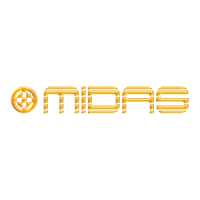Auxiliary Outputs
Note: Multifunction L and R channel signals are summed into a
to be routed to the auxiliary busses by the channel aux sends.
The Verona has eight (8) auxiliary outputs which can be used for
effects sends, monitor sends or as extra assignable outputs from the
console.
mono
signal
Pre-Fade
Post-Fade
Application Pre/Post Fade Reason
.
Aux Send Level
Aux 7/8 Pre
auxiliary (aux) 1-6 sends are sourced after the channel Insert, Mute and EQ but before the channel fader
(and EQ if the Aux Pre EQ switch is depressed). As a result, the actual level sent to the aux buss is proportional to
the aux send control only.
aux sends are sourced after the channel Insert, Mute, EQ and channel Fader. As a result, the actual
level sent to the aux buss is proportional to the aux send control AND the channel fader.
Typical uses of auxiliaries are:
Stage Monitors Pre (Post-EQ) The level in the monitor stays constant so that
the engineer can change the FOH level without
affecting the performer.
Effects Sends Post The level sent to the effects is proportional to the
level on the fader so the balance between wet
(processed) and dry (un-processed) sound
stays the same even when the channel level is
changed
Multi Track Recording Pre (Pre-EQ) The recording is made at constant level without
any equalisation so that changes in the mix level
and EQ can be set in post-production. (You can
also use the Direct Out for this but the output will
be at unity).
Mixed Recording Post (Post-EQ) If the aux is set to unity, the FOH mix is
replicated on the aux output including EQ but
excluding PAN
Aux sends 1 through 6 are always globally switchable pre or post fader. However, Aux 7 and 8 may individually be
sourced either Post Fader or Pre Fader using the selector switch on the channel and can not be pre-EQ.
Please note that, for illustration puposes, auxiliary 1 through 4 sends have been omitted but work in the same
manner as auxiliary 6 (illustrated).
- The auxiliary send level is continuously variable from off (-inf) to +6dB.
- Both aux 7 and aux 8 are assignable Pre or Post fader. When depressed, the
auxiliary is sourced pre-fader (i.e. the channel fader has no effect upon the level of the
signal sent to the auxiliary).
NOTE: Stereo modules can equally be used for mono signals (plugged in via the
microphone socket). The EQ on the stereo channels has fixed frequency high and low
sections which are optimised for vocals.
Operators Manual - Page 16
0
0
0
0
+6
+6
+6
+6
aux 8
pre
pre
aux 7
aux 6
aux 5
Multi Function Input ChannelsMulti Function Input Channels
mic gain
100
-15
-15
-15
-15
+15
+15
+15
+15
+30 +45
+60+15
mic
padpower
48V -15
mono
wide
stereo
0
0
0
0
0
0
0
0
+6
+6
+6
+6
+6
+6
+6
+6
image
line gain
treble
bass
stereo
hi-pass
80Hz
pan
c
l
+20
0
r
groups
pan
mute 1
mute 2
mute 3
mute 4
aux 1
aux 2
aux 3
aux 4
aux 8
mono
groups
stereo
1-2
5-6
7-8
3-4
pre
pre
aux 7
aux 6
aux 5
O
-18
0
12
18
eq
on
eq
aux pre
off
MIDAS
ins
300
500
600
3k
8k
1k2
1k5
hi-mid
lo-mid
SOLO
MUTE
10
10
5
5
0
20
15
30
40

